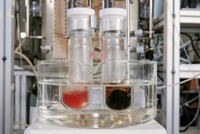Advertisement
Grab your lab coat. Let's get started
Welcome!
Welcome!
Create an account below to get 6 C&EN articles per month, receive newsletters and more - all free.
It seems this is your first time logging in online. Please enter the following information to continue.
As an ACS member you automatically get access to this site. All we need is few more details to create your reading experience.
Not you? Sign in with a different account.
Not you? Sign in with a different account.
ERROR 1
ERROR 1
ERROR 2
ERROR 2
ERROR 2
ERROR 2
ERROR 2
Password and Confirm password must match.
If you have an ACS member number, please enter it here so we can link this account to your membership. (optional)
ERROR 2
ACS values your privacy. By submitting your information, you are gaining access to C&EN and subscribing to our weekly newsletter. We use the information you provide to make your reading experience better, and we will never sell your data to third party members.
Environment
Patent Picks: Fracking Technology
A look at recent patenting activity in fracking technology, brought to you by C&EN and CAS
January 26, 2015
| A version of this story appeared in
Volume 93, Issue 4
Jump to Topics:
- Extra Heat Frees More Fuel
- Plant Enzymes Protect Fracking Fluids
- Biodegradable Polymers Leave No Residue Behind

In recent years, hydraulic fracturing—better known as fracking—has been a boon to oil and gas companies. The technique injects fracking fluid—typically made of about 90% water, 10% particulate matter, and less than 1% chemical additives—down into wells, fracturing shale deposits underground and releasing oil and natural gas. But fracking is not without its problems. To address issues such as low well productivity and environmental impact, scientists are now investigating, and subsequently patenting, improved additives for fracking fluids and greener extraction strategies. As seen in Chemical Abstracts Service databases, patents claiming improvements to fracking have grown steadily in recent years. Here, we focus on a handful of them.

In newly fractured wells, initially high oil and gas production rates usually drop quickly, to less than 20% of first-day rates. Jens Emil Vindstad and coworkers at Statoil Petroleum have patented a technique to address this problem. They claim that higher-than-normal fracking temperatures cause additional fracturing of underground shale deposits, decreasing the viscosity of trapped hydrocarbons and pyrolyzing kerogen to create recoverable hydrocarbons (WO 2014207108). Kerogen, typically left behind by most fracking operations, is a mixture of high-molecular-weight hydrocarbons present underground in solid form. Statoil carries out its process in two stages: The first stage uses temperatures in the range of 250 to 450 °C to reduce the solid high-molecular-weight kerogen to low-molecular-weight hydrocarbons. The second stage, which uses lower temperatures, then flushes out all the available hydrocarbons from the shale.
During fracking, operators force fracking fluids carrying proppants such as grains of sand or particles of aluminum oxide down wells to shale deposits. The proppants, which prop open fractures in the shale, get injected into those fractures with either high-pressure fluid or high-viscosity fluid. Plant-based thickening agents such as cellulose and guar gum are among the chemical additives that help increase fracking fluid viscosity. Sometimes though, bacteria growing in the fracking fluid cause premature breakdown of polysaccharide bonds in these thickening agents and the fluids lose viscosity. In a 2014 patent (WO 2014099191), Denton Sorrells from Schlumberger Technology claims that plant enzymes can prevent this premature breakdown. Sorrells suggests that a family of proteases, specifically cysteine proteases, is highly effective at protecting cellulosic thickening agents. They disable bacteria by selectively cleaving cellulases that decorate the microbes’ outer membrane, he says. It’s these cellulases that attack polysaccharide bonds. Not only do the plant enzymes work, the author contends, they’re economical: Many cysteine proteases can be easily extracted from plants and are commercially available.
Fracking can leave behind chemical residue. Scientists at DaniMer Scientific, now a part of Meredian Holdings Group (MHG), have been trying to solve the issue. In a recent patent, Steve Wann discloses a group of degradable polymers that impart a particular viscosity to fracking fluids, helping to transport proppants to shale deposits and create fractures (US 20140274820). The polymers—made from starting materials such as lactic acid and glycolic acid—are biodegradable, so they leave no residue after fracking, the patent claims. “These biodegradable polymers have drastically reduced the chemical and equipment footprint compared to current fracturing methods,” says Phil Van Trump, chief technology officer at MHG. The new approach costs less, making it practical to recover more oil or natural gas, Van Trump contends.
Patent Picks is a collaborative effort by C&EN and CAS. This feature reports on trends CAS scientists observe from patents in CAS databases. Patents now generate more than 70% of the new substances appearing in the literature.





Join the conversation
Contact the reporter
Submit a Letter to the Editor for publication
Engage with us on Twitter